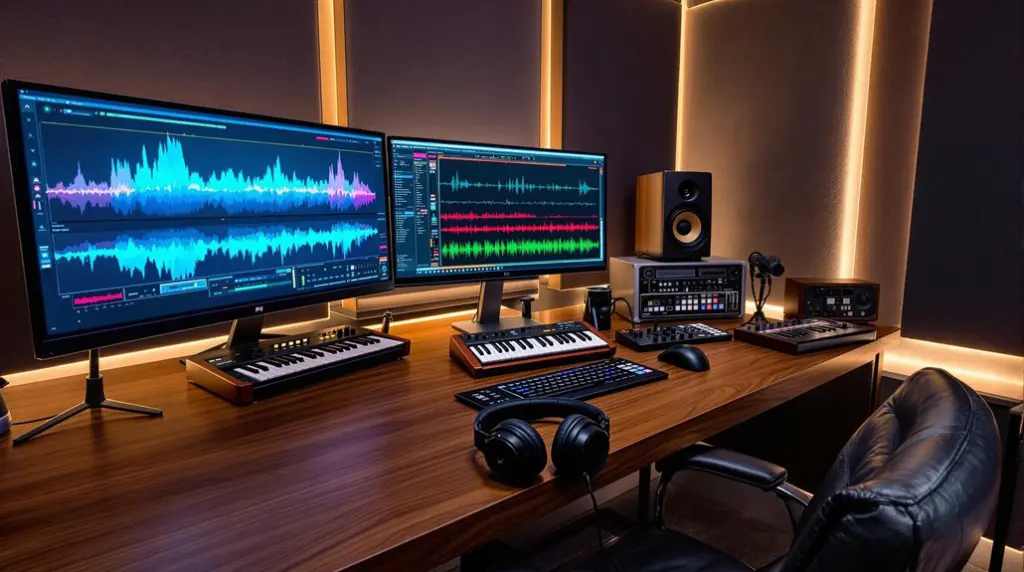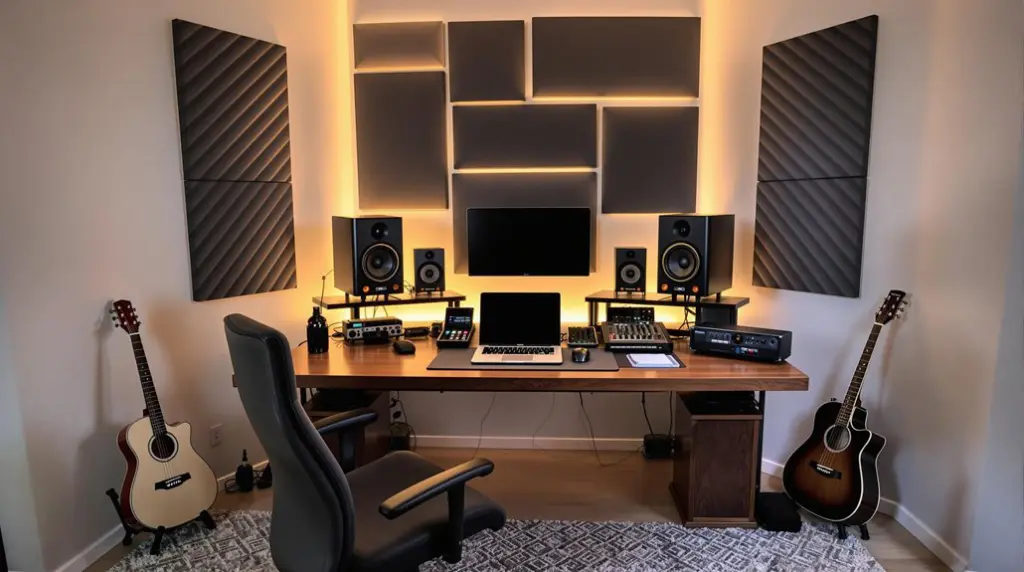To EQ your snare drum like a pro, first, understand its frequency fundamentals. Boost the 60-120 Hz range for fullness and cut muddiness around 200-300 Hz. Next, employ effective EQ techniques, including a high-pass filter at 70 Hz to eliminate rumble and boosts in the 3-5 kHz range for presence. Finally, avoid common mistakes such as over-boosting mid frequencies or neglecting the interaction with other instruments. Always reference professional mixes for guidance. Master these principles, and you’ll greatly enhance your snare sound. Further insights await you to refine your EQ skills even further.
Key Takeaways
- Start with a high-pass filter around 70 Hz to remove low-end rumble and enhance clarity.
- Boost frequencies around 200 Hz for warmth, but cut muddiness around 200-300 Hz for better definition.
- Focus on boosting 1-3 kHz to ensure your snare cuts through the mix effectively.
- Add snap by boosting high frequencies (3-5 kHz), but avoid over-boosting to prevent harshness.
- Use a spectrum analyzer to visually assess and refine your EQ adjustments for optimal sound balance.
Understand Snare Frequency Ranges
Understanding the frequency ranges of a snare drum is essential for achieving a polished and professional sound in any mix. The fundamental frequency of snare drums typically resides between 200-250 Hz, imparting warmth and body to the snare sound.
To enhance fullness, one can boost frequencies around 60-120 Hz, while cutting in the 200-300 Hz range effectively reduces muddiness.
For clarity and definition, it is vital to focus on the 1-3 kHz range, which allows the snare to cut through the mix. Additionally, high-frequency boosts in the 3-5 kHz range enhance the attack and snap of the snare.
Frequencies above 10 kHz can introduce airiness but should be applied judiciously to maintain a balanced mix when using an EQ Plug-in. Effective EQ techniques involve manipulating frequency ranges to shape the overall impact of the snare in the mix.
Apply EQ Techniques Effectively
To achieve an ideal snare drum sound in your mix, strategically applying EQ techniques is crucial.
Begin with a high-pass filter around 70 Hz to cut unnecessary low-end rumble, creating headroom for the kick drum. Next, boost frequencies between 150-200 Hz to enhance the snare’s body and thickness, but monitor for potential muddiness.
Implement a small cut around 400 Hz to reduce boxiness, improving overall clarity. To guarantee the snare cuts through the mix, boost the 3-5 kHz range, enhancing attack and presence without introducing harshness.
Utilizing a spectrum analyzer will aid in visualizing frequency response, allowing for targeted and informed EQ adjustments that refine your snare drum’s sonic characteristics effectively. Additionally, employing surgical EQ cuts can help eliminate unwanted resonances, ensuring your snare remains clear and defined in the mix.
Avoid Common EQ Mistakes
Steering through the complexities of EQ for snare drums requires vigilance to avoid common pitfalls that can compromise the mix. One prevalent mistake is over-boosting frequencies, particularly in the 3-5 kHz range, which can yield a harsh snare sound.
It is equally essential to cut unwanted frequencies, especially around 200-300 Hz, to prevent muddiness in the original snare sound. Furthermore, neglecting the snare’s interaction with other elements in the drum recording can lead to imbalanced EQ decisions.
Always reference professional mixes to inform your choices and guarantee your snare aligns with genre-specific tonal characteristics. Tailoring your EQ settings to the style of music you’re mixing is vital for achieving clarity and maintaining the integrity of the snare sound. Additionally, understanding how to manage frequency overlaps can further enhance the clarity of your snare in the overall mix.
Frequently Asked Questions
How to Properly EQ a Snare?
To properly EQ a snare, focus on its frequency ranges by applying high-pass filters, utilizing EQ plugins for precise adjustments, layering samples for depth, and considering snare reverb types to enhance acoustic characteristics in mixing drum tracks.
How to Get the Perfect Snare Sound?
Achieving the perfect snare sound involves precise snare tuning, strategic microphone placement, effective drum layering, and transient shaping. Incorporate ambient effects and genre-specific techniques while ensuring mixing balance through thoughtful sample selection to enhance overall impact.
How to Make Snares More Punchy?
To achieve punchy snares, apply effective snare layering techniques, utilize transient shaping tips, and implement precise compression settings. Consider reverb applications discussed, along with thoughtful tuning adjustments and ideal microphone placement strategies for enhanced impact in the mix.
How Do I Make My Snare Sound Better Logic?
To enhance your snare drum in Logic, apply effective mixing techniques such as frequency range adjustments, dynamic control, and audio effects. Utilize recording tips to refine layered sounds, achieving a polished and impactful snare sound.
Conclusion
In summary, achieving a professional-quality snare sound requires a thorough understanding of frequency ranges, the effective application of EQ techniques, and the avoidance of common mistakes. By meticulously analyzing the snare’s tonal characteristics and applying targeted adjustments, an ideal sonic profile can be attained. Continuous refinement of these skills enhances overall mixing proficiency and contributes to a well-balanced audio environment. Adhering to these principles guarantees that the snare sits appropriately within the mix, achieving clarity and impact.




